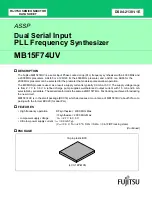
Plonk Manual
v1.01
Overview
Plonk
uses
a
technique
known
as
physical
modelling
to
synthesize,
with
great
realism,
the
way
in
which
sound
is
produced
by
acoustic
instruments.
The
Plonk
module
is
itself
focused
primarily
on
creating
percussive
sounds
—
both
pitched
and
un-pitched;
natural
and
unnatural;
acoustic-sounding
or
totally
electronic.
Plonk
does
this
by
breaking
sound
creation
into
two
distinct
elements
—
the
exciter
and
the
resonator
.
The
exciter
is
a
mathematical
model
of
the
device
used
to
strike
a
particular
surface.
Plonk,
because
it’s
percussion
oriented,
has
two
types
of
exciters:
one
modelled
on
a
mallet,
and
the
other
providing
a
noise
source.
The
resonator
is
a
virtualization
of
the
object
being
struck,
which
vibrates,
resonates
and
creates
the
body
of
a
sound.
Plonk
offers
several
types
of
resonators:
beam;
marimba;
drumhead;
membrane;
plate;
and
string.
Plonk
provides
numerous
parameters
that
let
you
shape,
mold
and
design
both
the
exciter
and
the
resonator,
thus
enabling
you
to
synthesize
the
sound
of
striking
or
scraping
almost
any
type
of
object
—
real
or
imagined.
In
this
way,
Plonk
can
accurately
model
the
sounds
of
kicks,
snares,
toms,
cymbals,
claps,
tablas,
congas
and
all
manner
of
traditional
percussion
instruments.
It
can
also
model
pitched
percussive
instruments,
like
vibes,
marimbas,
and
even
bass
or
guitar-like
tones.
Of
course,
it
also
excels
at
modelling
instruments
that
heretofore
never
existed.
Best
of
all,
the
sounds
created
by
Plonk
are
not
static
—
any
sound
you
design
can
respond
dynamically
to
velocity,
as
well
as
four
different
modulation
inputs.
This
means
the
sound
of
Page
4



































